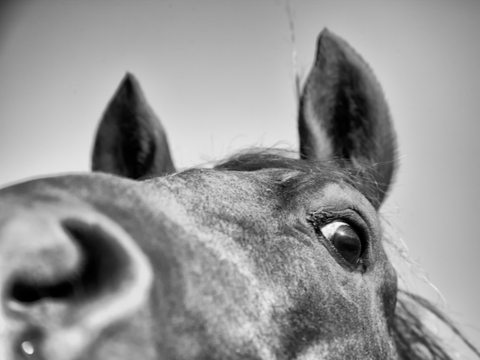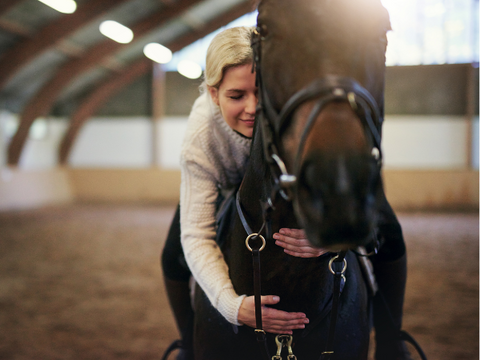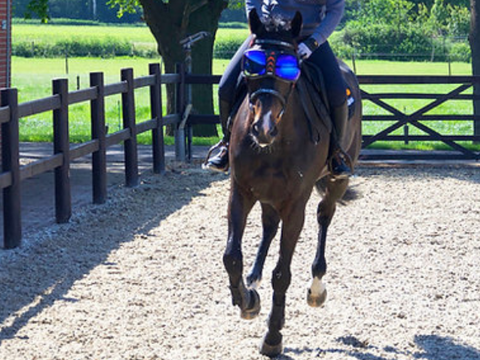Your basket is empty
Highly disabling, headshaking is a pathology that greatly hampers riding and can even alter the rider/horse relationship. Difficult to diagnose, this disorder requires in-depth investigations and specific support to enable the animal to regain a good quality of life and harmony with its rider.

The phenomenon of headshaking in horses owes its name to the swaying of the head that suggests the movement of the censer. While it may resemble the stereotypies frequently observed in the stall, headshaking is distinguished by the intensity and duration of the phenomenon, which does not subside during work sessions. In fact, headshaking is often more prevalent when the horse is active, and increases with the intensity of the efforts made.
These violent movements, of sudden or gradual onset, are performed on a vertical, horizontal or rotational plane. They appear to be triggered by facial pain (comparable to facial neuralgia in humans) when exposed to bright light or tactile stimuli such as the passage of air through the nostrils, rain or wind.
Whether constant or occasional, these repetitive movements are associated with signs of nasal discomfort such as sneezing, snorting, snorting, nasal spitting and rubbing of the muzzle on environmental supports and on the forelegs. The horse appears anxious, and some may even go so far as to self-mutilate or stop feeding altogether, such is the pervasiveness of the disorder. In these situations, riding becomes impossible, as the horse's behavior can be dangerous.
The first symptoms of headshaking generally appear in horses between 6 and 10 years of age, in spring or summer.
According to their severity, symptoms are classified into 5 grades:
Clinical signs generally worsen over time, to the detriment of the animal's quality of life. In 60% of affected horses, these symptoms appear in spring and summer, with sunny days leading to an increase in symptoms in certain horses known as photosensitizers.
At present, there is no clearly identified cause of headshaking, although the hypothesis of hypersensitivity of the trigeminal nerve is the most widely supported by veterinarians. More precisely, there are two types of headshaking, depending on their etiology:
The diagnosis of headshaking in horses remains highly complex. It is based more on exclusion criteria, i.e. on eliminating the various possible causes before concluding that headshaking has occurred. It can therefore take a long time to establish. In particular, the veterinarian will look for :
All these diagnostic possibilities are investigated before headshaking is considered, as Ludovic Tanquerel, veterinarian at the EnvA Ludovic Tanquerel, veterinary surgeon at the EnvA equine hospital, explains on video.. In addition to a history of the problem and a clinical examination, a number of tests can be carried out: head CT scan, X-ray, endoscopy, etc.

Like diagnosis, treatment of incensement in horses is complex, involving a combination of different techniques and molecules depending on the animal's profile and the severity of the disorder. The veterinarian may administer specific drugs based on sodium chromoglycate, carbamazepine, gonadotropin or cyproheptadine to relieve the horse.
There are also plant blends selected for their calming properties, such as Headshaking by Arbalou Equiexpert.
He may also prescribe sodium, magnesium and anti-inflammatories. Surgery on the trigeminal nerve may be considered: however, the success rate is only 49% 18 months after the operation. The use of dietary supplements helps reduce symptoms by reducing the animal's anxiety and preventing conditions that can lead to secondary structural incensement. These supplements also have the added benefit of soothing any pain that may occur as a result of the horse's repeated movements.
Neuromodulation is a nerve electrostimulation technique that seems to be proving its worth in the treatment of head tremors resulting from trigeminal nerve dysfunction. In a study published in 2019 on 168 horses, Véronica L.H. Roberts, researcher and lecturer at the University of Bristol (UK), showed that 53% of treated equines experienced a reduction in tremors lasting more than 9 weeks. The aforementioned Dr Ludovic Tanquerel also uses electrostimulation at the Hôpital des Equidés to treat horses suffering from headshaking.
Performed under light sedation, this technique "fatigues" the trigeminal nerve in sessions lasting several minutes, with increasing electrical intensity. The horse then enjoys remission for a few days. Repetition of these sessions leads to increasing remission, with up to 60% recovery after a year. While some horses are definitively cured following this electrostimulation protocol, the majority require a new session every year to maintain trigeminal nerve activity.

Since external stimuli are often triggers for incensing in horses, the use of a protective mask can limit the occurrence of the phenomenon and help relieve the animal of discomfort and pain. While a nose net reduces the passage of air through the nostrils and tactile stimulation, it cannot protect the eyes from bright light in photosensitive incense burners. The use of an anti-UV mask with earmuffs and nose-patch meets the horse's need for full head protection..
In the meadow, in the stable, working outdoors or on the flat, the equidival mask offers 90% UV protection. It also protects against dust, insects and wind. Anti-UV goggles are particularly recommended for working sessions.offering 100% protection. Their tint varies according to the horse's needs and the activity practised. They are also authorized for dressage competitions.
If your horse suffers from headshaking, there are solutions to help him improve his daily well-being. Alongside the implementation of a specific veterinary protocol, the use of a high-protection face mask and the administration of dietary supplements can help relieve stress and limit sources of discomfort. Soothed, your equine companion regains pleasure and serenity, fostering a new harmony between horse and rider.
Sources :
Incensement in horses: clinical signs, prevalence, pathophysiology
Pratique Vétérinaire Equine n° 219 of 01/10/2023
Headshaking in horses
La Semaine Vétérinaire n° 1743 dated 07/12/2017
All measurements are approximate and for guidance only.

| Mask size | Head circumference |
| XS - Shetland | 84 cm |
| S - Pony | 90 cm |
| M - Cob | 94 cm |
| L - Full | 100 cm |
| XL - XFull | 110 cm |
For these masks, the main measurement is that of your horse's forehead. To do this, add up 3 measurements:
Add these 3 measurements (A+B+C) to obtain the size of your horse's forehead.
IMPORTANT: do not measure directly from one eye to the other, as this will probably result in a measurement that is too small.

| Mask size | Forehead size |
| XS - Shetland | 18-21 cm |
| S - Pony | 22-28 cm |
| M - Cob | 29-33 cm |
| L - Full | 34-37 cm |
| XL - XFull | 38-43 cm |

| Size | A | B | C |
| XS (large shetland) | 60 cm | 84 cm | 20 cm |
| S (pony) | 70 cm | 96 cm | 23 cm |
| M (cob) | 70 cm | 96 cm | 25.5 cm |
| L (full) | 75 cm | 105 cm | 27 cm |
If your horse is between two sizes, we advise you to take the smaller size.
| Mask size | Distance between eyes |
| S - Pony | 18 cm |
| M - Cob | 21 cm |
| L - Full | 24 cm |
| XL - XFull | 26 cm |

Are you mistaken? An exchange is always possible, and we'll do it as quickly as possible, as long as you return the item, undamaged, within 14 days.
> See return conditions